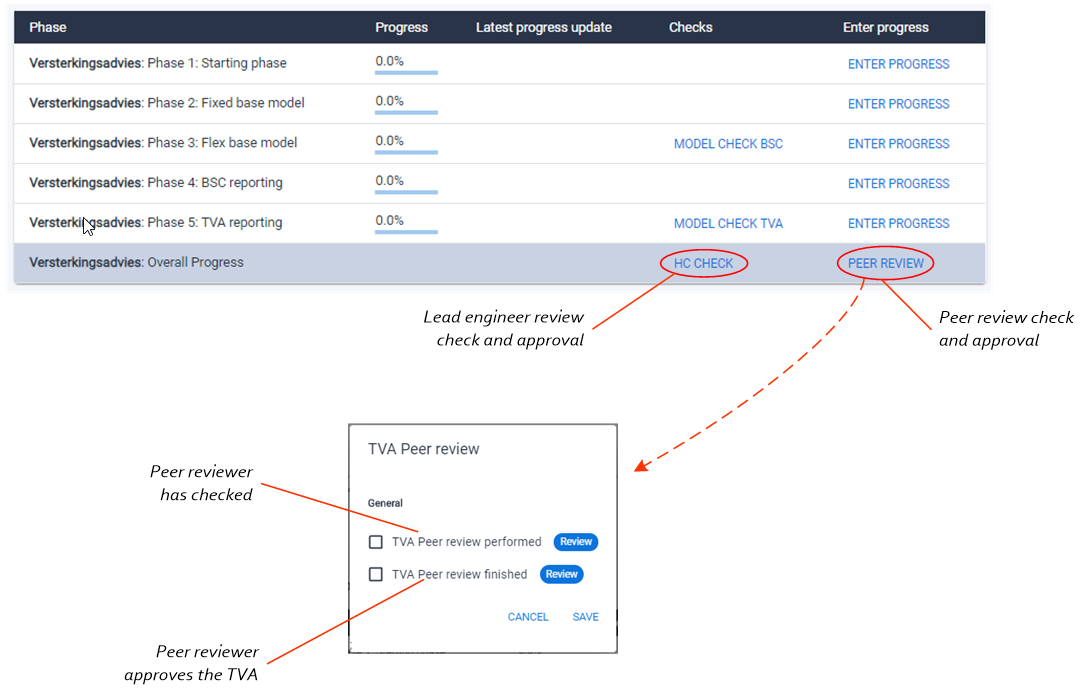How to do peer review
The draft of the engineering report (including appendices) is reviewed by a colleague involved in the VIIA Project. This check includes report contents, calculation, design decisions and report quality. It also checks if the model check was performed correctly. The internal review documents (peer review and lead-engineer review) shall be stored in a sub-folder in the folder ‘01 Concept’.
When the peer review is finished, the reviewer needs to mark it as completed in MYVIIA (engineering-tab).

Figure 190 Reporting peer review check and approval in MYVIIA.
Some explanatory remarks about the peer review:
Model check shall be performed already in an earlier stage, verify if it is completed before proceding.
Before sending the deliverable for review the author of the document shall check the document itself and be convinced that the content is correct, complete and comprehensible (including quality of text and images).
As a result of the review the peer reviewer shall be convinced that the content of the reviewed deliverable is correct, complete and comprehensible.
The peer reviewer has to have enough knowledge to check the specific deliverable, it is possible that the peer reviewer fills gaps in the knowledge by asking questions and/or discussing the deliverable with the author.
The peer reviewer should be the same person who performed the model check for efficiency.
It’s a 100%-100% shared responsibility.
The author is responsible for setting up a correct, complete and comprehensible deliverable.
The reviewer is responsible via the reviewing role for that same quality of the deliverable.
The peer reviewer’s signature has the same weight as the author’s signature.
The goal of the review is to get all mistakes out.
The peer review is a full check of the deliverable.
Starting points, approach and blind spots (among others) are to be checked by the Lead Engineer (the extra pair of eyes).
Sanity checks (if necessary, see also FEM manual) should be part of the deliverable (so not done by the reviewer).
The peer reviewer needs to check the inspection report before/while performing the peer review along with the photos of the object.
Important aspects to check:
Check word references (obvious mistakes like see section 0 or, errors).
Rough check of language (spelling checker in word already does a lot, is it activate?).
Check that the deformation results are in the correct direction. Are the results of the NLTH model shown in the report in the right direction?
Min/max results are reversed with the captions (caption says min picture is max or vice versa).
Incorrect address: check if the address is correct along all the documents of BSC and TVA.
Check the BKCL.
Check the QC (Quality Check document) and fill in the QC document in the sections for the peer reviewer.
Check the Issuelog.
PSSE and NSCE:
Does the peer reviewer agree with the classification of PSSE and NSCE?
Is the classification consistent with the inspection report?
Is the classification consistent with the assessment?
Is the classification consistent along all the documents of the BSC and TVA?
NLTH-REF
Specific remarks for the NLTH-REF objects and assessments:
Does the peer reviewer agree with the NLTH objects used for comparison based on the specific assessment?
Check if description of critical elements is clear and correct.
Check if anyone uses “xx does not require assessment” or “The building/element is guaranteed to be safe”, this is something we should never say. These elements are estimated to be safe or not causing lethal hazard based on engineering judgement, past experience or the NPR.
If a tool has been used for the assessment, check the input for the tool and also the results (example for OOP assessment: are the data of the L4 tool correctly filled in in the invoer table? Is it the wall assessed correctly (1-way bending or 2-way bending)? In case of NLKA: Is overburden load, teta value, boundary conditions correct? If it is a cavity wall with cavity ties, has the wall been assessed correctly, as a system?).
Workflow
The structural engineer will ask for a peer review when he knows when he expects to finish. Then he will inform the reviewer when all the files are available and complete. The reviewer should not start earlier. The review is performed and comments are added to the documents in the peer review folder. The engineer is informed and it is recommended that the reviewer and engineer discuss the comments.
The engineer updates the documents or responds to the comments why he did not implement as requested by the reviewer. In case of a dispute after discussion of the comment the LE can assist. When engineer is finished with the comments he informs the peer reviewer. And he again checks all documents for the changes. This process continues until the reviewer completely agrees to the contents (as if he would himself be handing over to the client). He than informes the engineer and approves the document on MYVIIA.